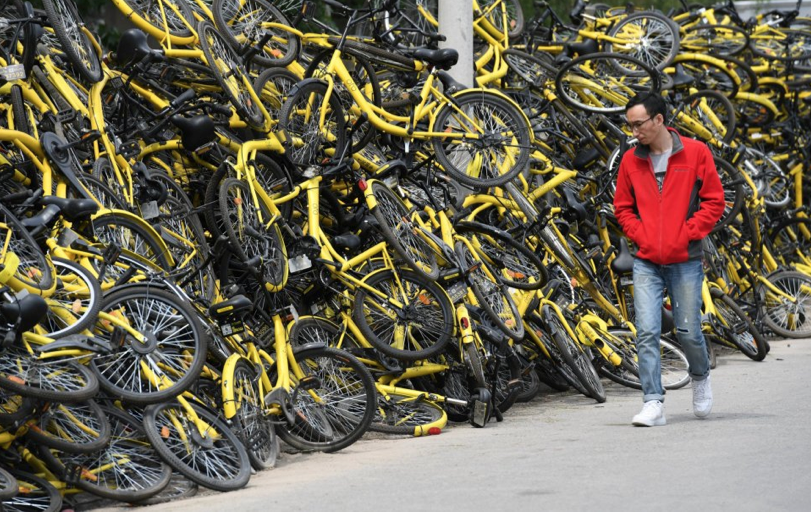CommentsDEEGAN ON LA-The phenomenon of Bike-Sharing -- either “station to station” or “dockless” -- is experiencing a rise in popularity similar to the explosion seen in “ride-hailing” services like Uber and Lyft.
Station-to-station means you pick up and return your shared bike to a station, while dockless means you park and walk away from your shared bike wherever you are once you have finished your ride.
Suddenly and some say dangerously, a sub-set of undocked bike sharing is emerging in the form of “electric scooter-sharing.” It is making a splash in the “alternative mobility world” but is causing concern because it is not connected to any form of regulation or safety standards. Politicos and the Department of Transportation (DOT) are currently formulating dockless bike sharing guidelines and appear to be ahead of the curve of the expected expansion of e-scooter use.
New Urbanists have always known that their lifestyle preference of working, shopping, dining, and playing close to home helps solve traffic problems for them. Most city residents are still spending lots of time in cars moving between distant points for these activities. But shifting the ratio of car transportation time to alternative multi-model transportation time is getting easier with so many offerings available to satisfy movement needs.
Living in Los Angeles can be a challenge for anyone who is forced to traverse the urban mass. New Urbanists know that the “spread-out” model is broken, and many have chosen various methods to get around, including cars, ride services, bikes or walking. Bike sharing and e-scooter sharing have added to a wide assortment of mobility options.
Here are some of the ways you can move around locally without using your car:
- Walk
- Bike
- Transit (bus and subway)
- Taxi
- Ride Hail (Uber and Lyft)
- Bike share (Station to Station and Undocked, aka Dockless-on-Demand)
- E-Scooter (Undocked)
Other than riding one’s own bike or walking, bike sharing is the most widespread method of alternative mobility in the country. There has been a twenty-five percent increase in bike share trips nationwide in the most current reporting period, according to the National Association of City Transportation Officials that put the total number of bike share trips in that period at 35 million.
What is the technology and process that makes dockless-on-demand bike sharing work? It’s simple: download an app to your phone, open an account and enter your credit card for billing (per minute rates are very affordable, and you're only billed for the minutes you use); then use the GPS-enabled search function to locate the nearest dockless bike. Go to it, use the app to scan the QR code (a type of barcode) on the handlebar that will unlock the bike for you. Then you hop on the bike and ride away. When you're done, park and lock wherever you are, using the app that will also close your usage and billing. That bike remains locked in place until the next user claims it. However, avoiding bike pile-ups that obstruct the public walkways is a concern.
Los Angeles has been late to the pedal party, only recently taking a serious look at implementing and regulating dockless-on-demand bike sharing. Last October, Councilmember David Ryu (CD4) presented a Motion for Dockless Bike Share Systems /Pilot Program.
Jumping into the future, Ryu’s motion stresses “dockless bike sharing” which is the most avant-garde form of bike rental.
Ryu’s motion, which is being acted on by the DOT, was “to test dockless bike sharing in Los Angeles and generate data and feedback on how to design a dockless bike sharing regulatory model that enables dockless bike sharing while mitigating the risk of bikes being left in a fashion that clutters the public right of way.”
DOT has drafted Rules and Guidelines for Dockless On-demand Personal Mobility Services that will require all dockless-on-demand bike sharing operators to submit a community engagement plan as part of their permit applications, get a sign-off from each council district where they want to do business, “mitigating the risk of bikes being left in a fashion that clutters the public right of way” as Ryu calls for in his motion.
We already have a bike sharing program run by Metro, called Metro Bike Share, a station-to-station format that works like renting a car: pick up at one location and drop it off back there or at another authorized location.
The emerging popularity of e-scooters has made its mark in Venice and on Westwood’s UCLA campus where it is totally unregulated, as well as in Santa Monica (its birthplace) where the city is trying hard to set guidelines for usage. Unlike bikes, e-scooters are motorized vehicles and badly need tougher regulation. They, too, can clutter sidewalks as people end their rides and leave them in place. Santa Monica, where the e-scooter concept originated, has been developing regulations that include mandating helmets, riding off sidewalks, and requiring riders to be of legal driving age.
These are all serious concerns that fold into the measured attempt of Los Angeles to run a pilot program for dockless-on-demand bike sharing (and eventually dockless e-scooters) and determine what is possible as the need for expanding alternative transportation is recognized by politicos and further embraced by New Urbanists.
(Tim Deegan is a civic activist whose DEEGAN ON LA weekly column about city planning, new urbanism, the environment, and the homeless appear in CityWatch. Tim can be reached at [email protected].) Edited for CityWatch by Linda Abrams.
















